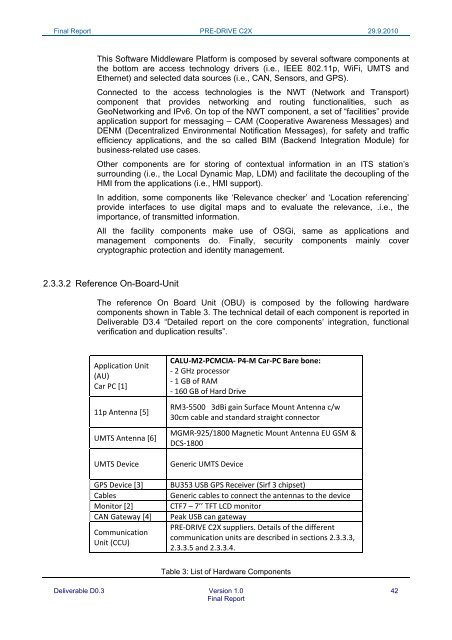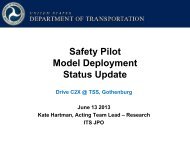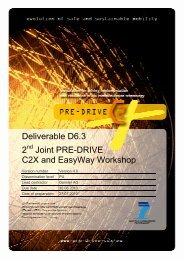PRE-DRIVE C2X Deliverable D0.3 Final report_20100929.pdf
PRE-DRIVE C2X Deliverable D0.3 Final report_20100929.pdf
PRE-DRIVE C2X Deliverable D0.3 Final report_20100929.pdf
Create successful ePaper yourself
Turn your PDF publications into a flip-book with our unique Google optimized e-Paper software.
<strong>Final</strong> Report <strong>PRE</strong>-<strong>DRIVE</strong> <strong>C2X</strong> 29.9.2010<br />
This Software Middleware Platform is composed by several software components at<br />
the bottom are access technology drivers (i.e., IEEE 802.11p, WiFi, UMTS and<br />
Ethernet) and selected data sources (i.e., CAN, Sensors, and GPS).<br />
Connected to the access technologies is the NWT (Network and Transport)<br />
component that provides networking and routing functionalities, such as<br />
GeoNetworking and IPv6. On top of the NWT component, a set of “facilities” provide<br />
application support for messaging – CAM (Cooperative Awareness Messages) and<br />
DENM (Decentralized Environmental Notification Messages), for safety and traffic<br />
efficiency applications, and the so called BIM (Backend Integration Module) for<br />
business-related use cases.<br />
Other components are for storing of contextual information in an ITS station’s<br />
surrounding (i.e., the Local Dynamic Map, LDM) and facilitate the decoupling of the<br />
HMI from the applications (i.e., HMI support).<br />
In addition, some components like ‘Relevance checker’ and ‘Location referencing’<br />
provide interfaces to use digital maps and to evaluate the relevance, .i.e., the<br />
importance, of transmitted information.<br />
All the facility components make use of OSGi, same as applications and<br />
management components do. <strong>Final</strong>ly, security components mainly cover<br />
cryptographic protection and identity management.<br />
2.3.3.2 Reference On-Board-Unit<br />
The reference On Board Unit (OBU) is composed by the following hardware<br />
components shown in Table 3. The technical detail of each component is <strong>report</strong>ed in<br />
<strong>Deliverable</strong> D3.4 “Detailed <strong>report</strong> on the core components’ integration, functional<br />
verification and duplication results”.<br />
Application Unit<br />
(AU)<br />
Car PC [1]<br />
11p Antenna [5]<br />
UMTS Antenna [6]<br />
UMTS Device<br />
GPS Device [3]<br />
Cables<br />
Monitor [2]<br />
CAN Gateway [4]<br />
Communication<br />
Unit (CCU)<br />
CALU‐M2‐PCMCIA‐ P4‐M Car‐PC Bare bone:<br />
‐ 2 GHz processor<br />
‐ 1 GB of RAM<br />
‐ 160 GB of Hard Drive<br />
RM3‐5500 3dBi gain Surface Mount Antenna c/w<br />
30cm cable and standard straight connector<br />
MGMR‐925/1800 Magnetic Mount Antenna EU GSM &<br />
DCS‐1800<br />
Generic UMTS Device<br />
BU353 USB GPS Receiver (Sirf 3 chipset)<br />
Generic cables to connect the antennas to the device<br />
CTF7 – 7’’ TFT LCD monitor<br />
Peak USB can gateway<br />
<strong>PRE</strong>‐<strong>DRIVE</strong> <strong>C2X</strong> suppliers. Details of the different<br />
communication units are described in sections 2.3.3.3,<br />
2.3.3.5 and 2.3.3.4.<br />
Table 3: List of Hardware Components<br />
<strong>Deliverable</strong> <strong>D0.3</strong> Version 1.0 42<br />
<strong>Final</strong> Report







